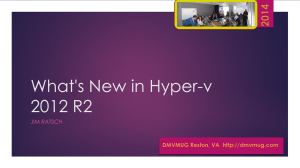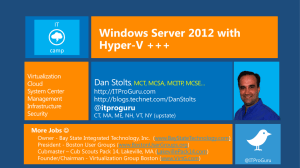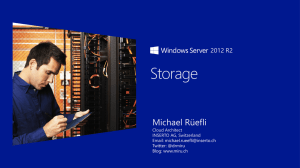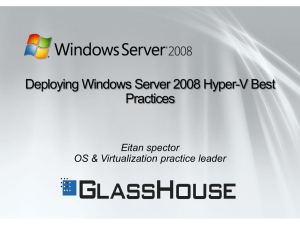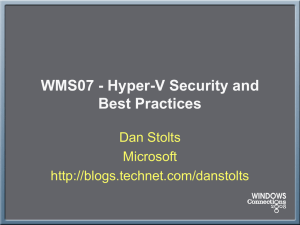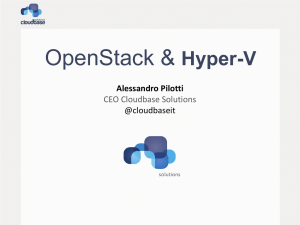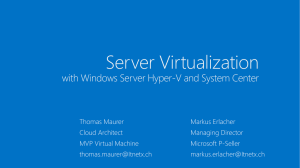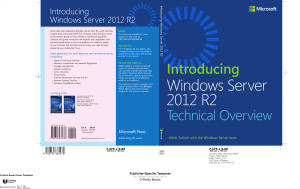Cluster
advertisement
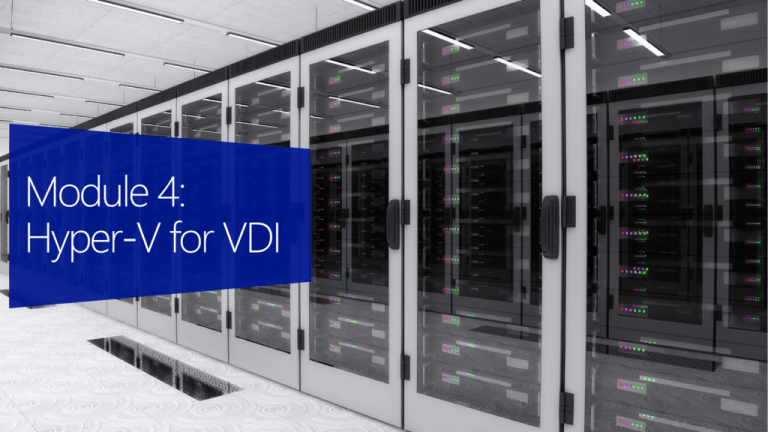
Parent Partition VM Worker Processes Child Partitions Applications Applications Applications Applications Windows Server 2008, 2012 Non-Hypervisor Aware OS Linux Kernel WMI Provider VM Service Windows Server 2012 Windows Kernel IHV Drivers VSP VMBus Windows Kernel VSC VMBus Linux VSC Windows Kernel Emulation User Mode VMBus Hypercall Adapter Windows hypervisor “Designed for Windows” Server Hardware Kernel Mode Ring -1 VM 1 (Admin) VM 2 VM 3 VM 1 (“Parent”) Virtualization Stack Hypervisor Drivers Drivers Drivers Hardware Drivers Drivers Drivers VM 2 (“Child”) Drivers Drivers Drivers Hypervisor Hardware VM 3 (“Child”) Drivers Drivers Drivers System Host VM Cluster Windows Server 2008 R2 Hyper-V Windows Server 2012 Hyper-V Improvement Factor Logical Processors 64 320 5× Physical Memory 1TB 4TB 4× Virtual CPUs per Host 512 2,048 4× Virtual CPUs per VM 4 64 16× Memory per VM 64GB 1TB 16× Active VMs per Host 384 1,024 2.7× Guest NUMA No Yes - Maximum Nodes 16 64 4× 1,000 8,000 8× Resource Maximum VMs BEST VALUE FOR VDI Use direct-attached storage, network-attached storage, and clustered or SAN storage Provide configuration options to optimize for tiered storage Reduce storage cost while maximizing I/O operations per second 8 New in Windows Server 2012 • • • • VDI Storage Configuration • • • • New flexible storage solution for virtual or cloud infrastructure • Virtually no application downtime for planned maintenance and unplanned failures • Data store for Microsoft SQL Server databases and Hyper-V workloads • Highly available scale-out file server • Active/active access • Built-in encryption support • Single namespace for file system New in SMB 3.0 SMB Transparent Failover SMB Scale Out SMB Multichannel SMB Direct SMB Directory Leasing SMB Encryption SMB-Specific PowerShell Performance Counters for cmdlets server applications Improved performance optimizations • Server Message Block overview: http://technet.microsoft.com/en-us/library/hh831795.aspx • Can store virtual machine files (configuration, VHD, snapshots) in files shares over the SMB 3.0 protocol • Is supported for both stand-alone and clustered servers that use Hyper-V with shared file storage for the cluster • Can support scale-out file shares and clusters • Can leverage SMB Multichannel Why Should I Care? Ease of storage provisioning and management You can manage file shares instead of storage fabric and logical unit numbers (LUNs) Previously all Hyper-V clusters required shared storage using Fibre Channel, Fibre Channel over Ethernet, iSCSI, or Serial-Attached SCSI Increased flexibility You can dynamically migrate virtual machines or databases in the data center Ability to take advantage of existing investment in a converged network You can use your existing converged network with no specialized storage networking hardware Reduced capital expenditures Capital expenses (acquisition costs) are reduced Reduced operating expenditures You can reduce operating costs because there is no need for specialized storage expertise • • • One or more computers running Windows Server 2012 with the File Services role installed One or more computers running Windows Server 2012 with the Hyper-V role installed (separate from the file server) A common Active Directory infrastructure • The servers running Active Directory Domain Services (AD DS) do not need to run Windows Server 2012 Constrained delegation Supported configurations Standalone Hyper-V servers (not a high-availability solution) Hyper-V servers configured in a failover cluster Although not required, failover clustering is supported on the Hyper-V side, the File Services side, or both. They must be separate clusters. Standalone File Server/ Clustered Hyper-V Clustered File Server/ Standalone Hyper-V All Clustered





